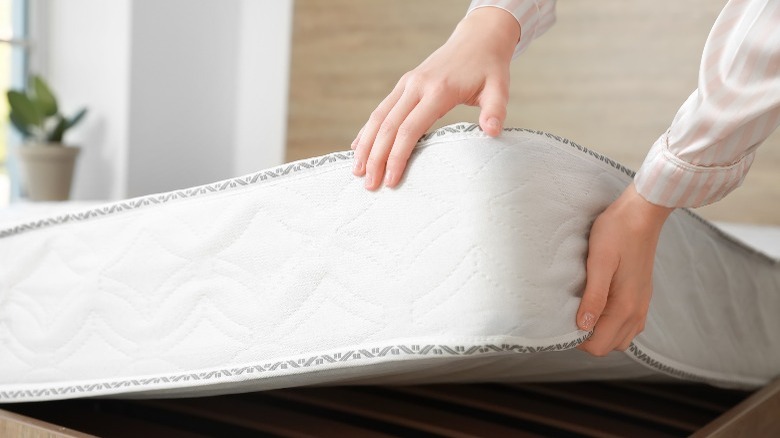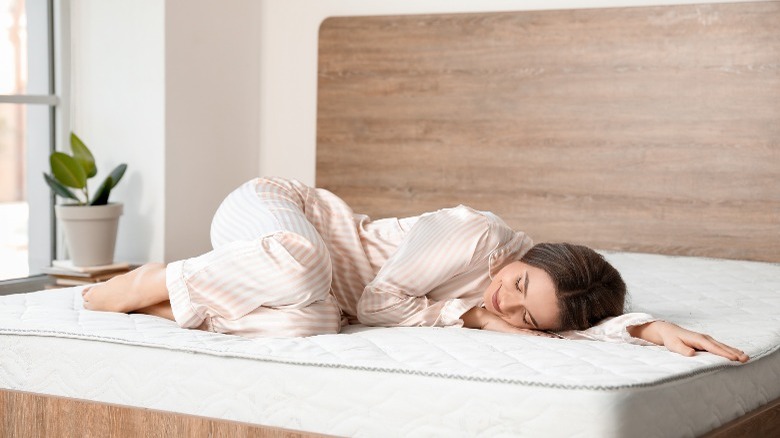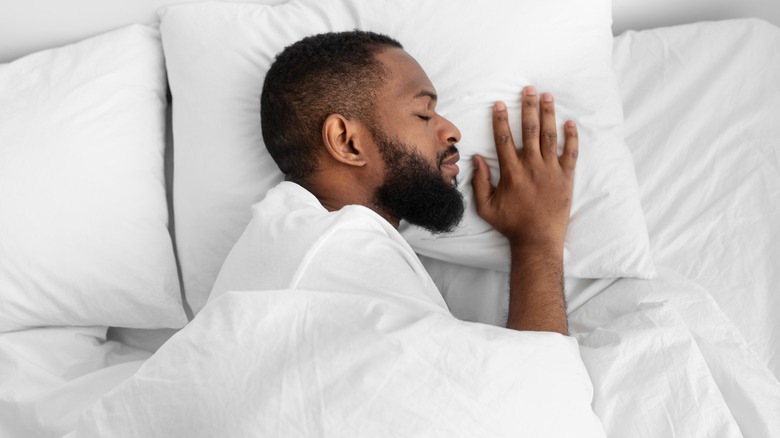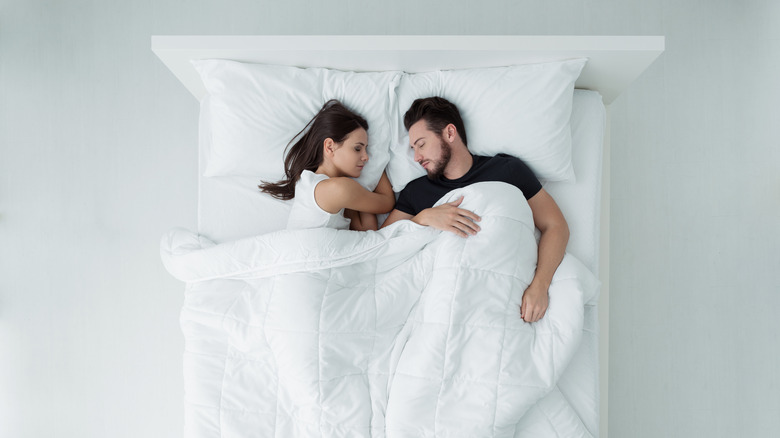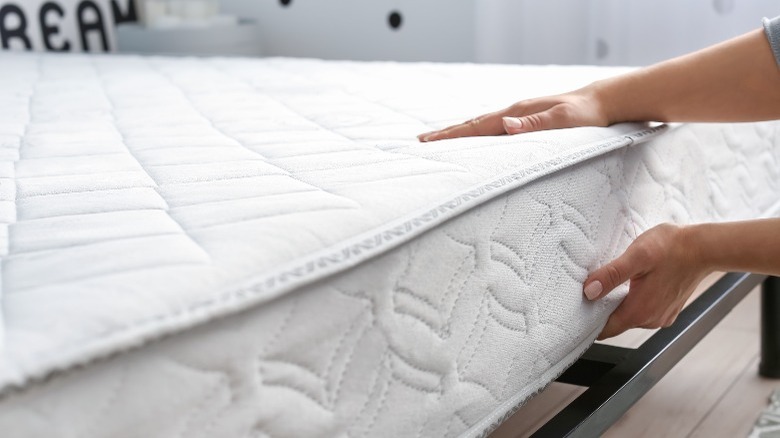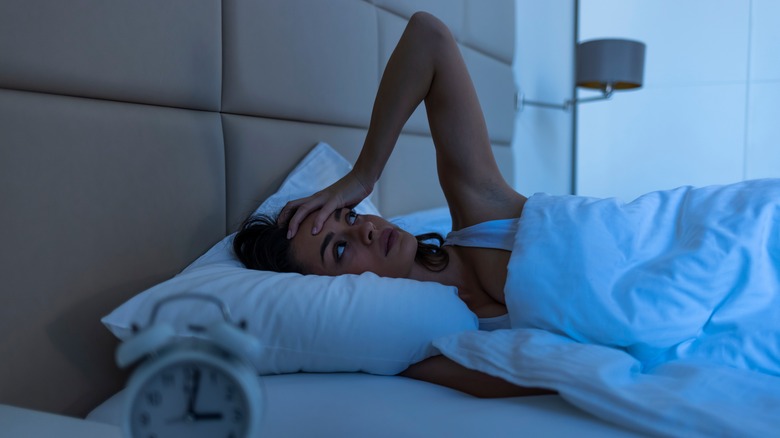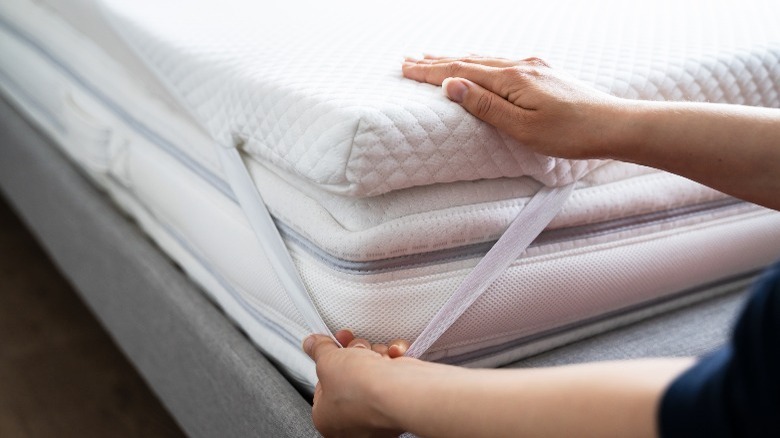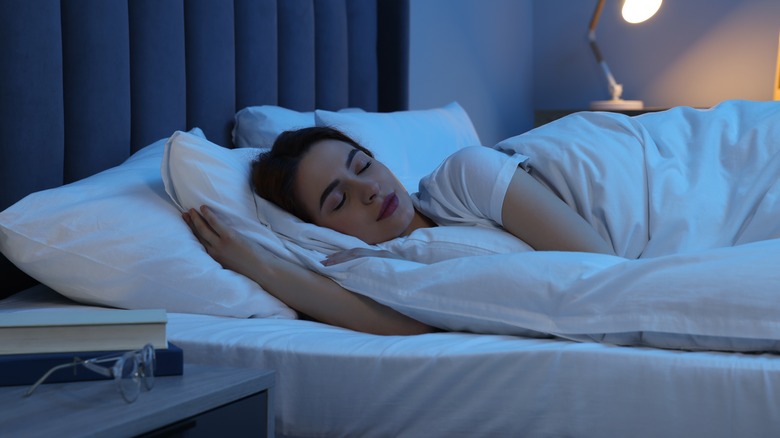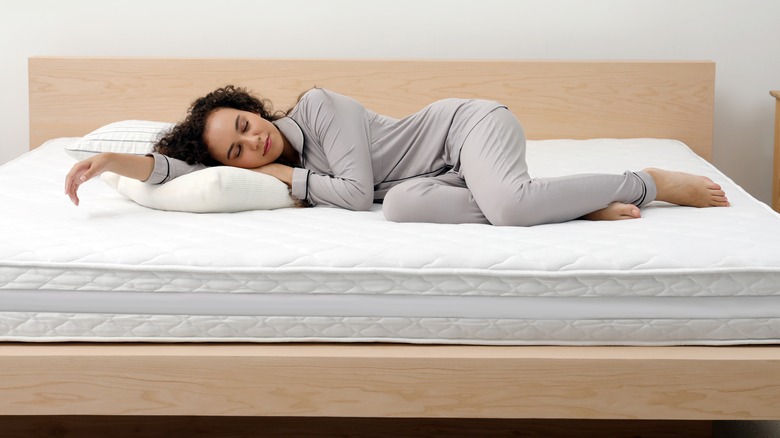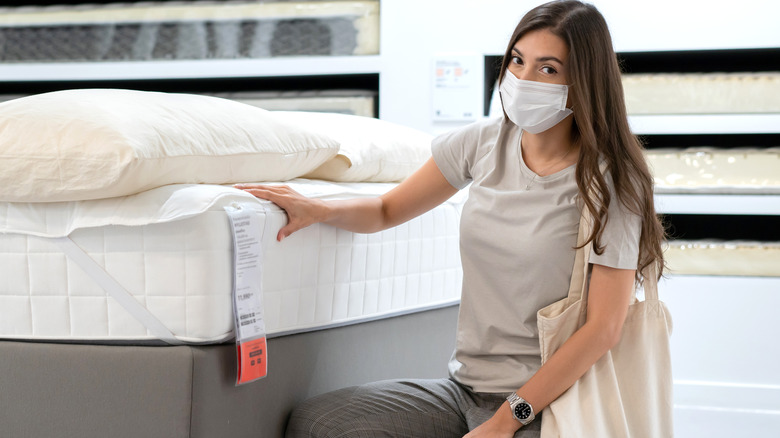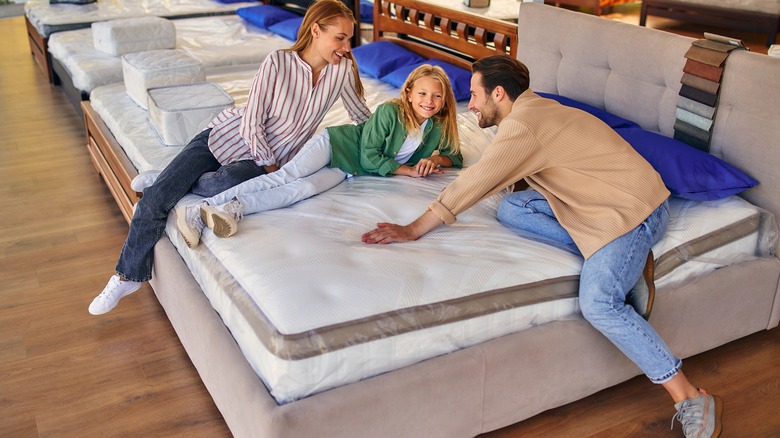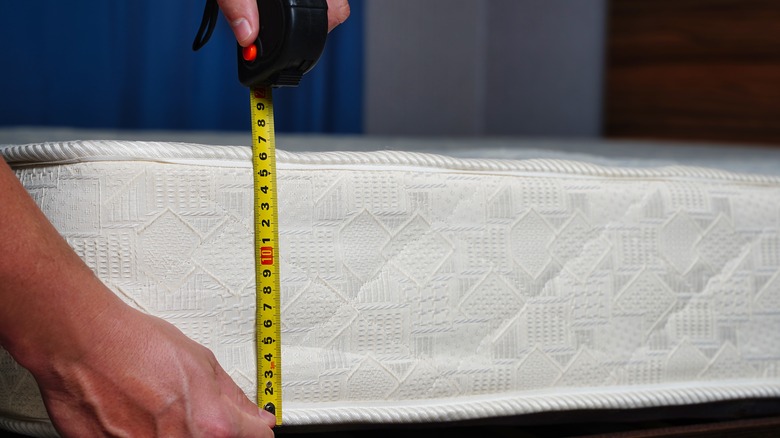How To Choose The Best Mattress
If you're looking for a new mattress but have no idea where to start, you've come to the right place. We're here to help give you some great tips and helpful advice about things to consider when looking for a new mattress. After all, according to the Sleep Foundation, adults need about seven to nine hours of sleep nightly. That means, on average, we spend about a third of our lives on our mattresses! Therefore, agonizing over finding just the right one is perfectly natural. There are so many different variables and seemingly endless kinds of sleepers.
Half of all U.S. citizens report feeling lethargic and sleepy at least three or more days a week. Additionally, between 10% and 30% of adults have chronic insomnia, and when referring to older adults, the percentage jumps from 30% to 48%. This sounds like an awful lot of people who aren't sleeping on a mattress that's conducive to their best sleep. And with all the choices that are out there today, doesn't that seem like a shame? Read on for some helpful information about choosing the best mattress so you can get the best night's sleep possible.
Familiarize yourself with the types of mattresses
Mattress and bed trends come and go, for instance, some of us remember when waterbeds were in. Nowadays, you'd be hard-pressed to find a new one, although they're still sold by a few select retailers. According to Casper, there are just a few main types to familiarize yourself with. They include innerspring, memory foam, gel-infused foam, polyfoam, hybrid, and latex.
Innerspring mattresses are one of the most common types and are great for those on a budget. They are made with a supportive combination of coils and springs and are good for those with back pain (via Mattress Firm). Memory foam mattresses provide full body support and relief from pressure that can help body pain sufferers. The stable surface also makes it so people that sleep together can move around without bothering the other person. Hybrid mattresses combine spring and foam to bring you the best of both worlds. Some manufacturers also offer latex foam options for users that want the support of memory foam with a firmer surface. Gel-infused foam mattresses help warm sleepers stay cool, and polyfoam is a high-resiliency foam similar to memory foam but can be very expensive.
Choose your level of firmness
It's a well-known fact that some people sleep better with a firm mattress, some people prefer a soft mattress, and some prefer somewhere in between. It's therefore perfectly understandable that purchasing a new mattress can be a challenge. Sleepopolis explains that a perfect mattress should allow your body to be aligned from head to toe and eliminate the feeling of pressure in any specific area. A lot of this alignment is determined by the shape and curvature of your spine. This makes it important to find the just-right mattress to fully support your spine and its unique shape.
This is why choosing the best mattress includes deciding how firm the mattress should be. According to the Sleep Foundation, support and firmness are two different qualities of a mattress, though they are often intermingled. The level of support comes from the internal structure of the mattress and how it's designed. The firmness has to do with the outer layer that your body makes contact with and how soft or firm the material is. This ranges from extra soft to extra firm. Everything from your body weight, body temperature, and personal preference can come into play when determining your ideal firmness level.
Understand the role of sleep position
Most of us are familiar with the fact that we sleep in a specific position the majority of the time. According to Mattress Advisor, the mattress firmness you choose can be partially decided by knowing your typical sleep position. There are just three main types of sleep positions, side sleepers, back sleepers, and stomach sleepers. The vast majority of people sleep on their sides, especially women. Very few people sleep on their backs because of the lack of spine support and the prevalence of snoring in this position. There's also a small number of people that sleep on their stomachs. However, this can lead to a painful misalignment of the spine. Of course, there are also combination sleepers, in which case you're advised to choose the dominant position you find yourself in most often.
When shopping for mattresses, keep in mind that the firmness range is given on a scale of 1-10, with 1 representing the softest and 10 being the most firm. Sleeping on your side is good for your circulation and spine, and a mattress firmness anywhere between 3 and 7 can provide great support. For back sleepers, a firmness level of between 5 and 8 is ideal to provide more spinal support. Stomach sleepers should look for a mattress with a firmness between 6 and 9 to minimize it sinking under their body weight.
Know your body type
Your body type and size also play a role in proper mattress selection. Whether you were born a man or woman can be a big factor. Michael Breus, Ph.D., a clinical psychologist and fellow of The American Academy of Sleep Medicine, tells Saatva, "Women often have more of a dip in the small of their back, so if you're a woman and you're a back sleeper, you should make sure the mattress has latex or foam on top. That way it can mold to your body and support you while you sleep."
Your height and weight matter as well. Taller sleepers might need the added length that a king or California-king mattress provides. However, shorter sleepers might have a difficult time getting in and out of taller, thicker mattress options. The amount you weigh can also help you determine the level of support that you require. One common situation is having two partners with different body types. In this case, you can opt for a split king, with each person having a half designed for their body type. Or, look into dual-adjustable options where you can each choose the just-right settings for your individual sides.
Consider types of mattress fabrics
In addition to firmness, support, and comfort level, another decision to make when choosing the right mattress is the fabric covering. According to John Ryan By Design, this is called mattress ticking. Choosing the right one for your needs can be overwhelming due to the multitude of choices and the features available.
The most common of these coverings is damask. This is a soft and breathable option that comes in a high range of price points. This reflects the diversity of the quality levels and fabric types that are available. A lower-priced option that is often used on economy-level mattresses is stitchbond. This material is stiff and uncomfortable but is resilient if durability is a top priority.
Knit mattress coverings are typically called micro quilts and are often made from stretchy synthetic fabrics. These are super soft and highly breathable for ultimate comfort. This is a popular choice for covering mid-range mattresses including memory foam options. For those wanting to invest more, there are specialty mattress coverings as well. These claim to feature additional benefits like allergen reduction and elimination of bacteria. There are also fabrics that provide temperature control and pleasant fragrances for those willing to pay the higher price point.
Signs it's time for a new mattress
Although we've already gone over lots of great information on how to choose the best mattress, one thing you might still be wondering is, how do you know when to buy a new mattress? Well according to CreditDonkey, there are a few things you can use as a guide, such as the age of your current one. Most mattresses should last around eight years, but there are other signs besides old age to give you some clues. For example, if you toss and turn all night and just can't seem to find a comfortable position, it could very well be your mattress. An outdated mattress could also be the culprit if you wake up sore in the morning.
Inspect the look and feel of your mattress for more clues. Is it starting to feel lumpy and uneven? Is it beginning to sag where you sleep? These could be signs it's time to replace your mattress. Lastly, if your body type or health conditions have changed, it's time to reevaluate if your mattress is still the right one for your needs.
Best mattress for back pain
According to NCBI, an estimated 23% of the global population deals with chronic pain in their lower back. That could mean that there's a significant number of people looking for mattress options that reduce back issues. While of course, it's not a one-size-fits-all answer, there are definitely some tips you should know.
Keep in mind that comfort and support are two different things. For back pain, a combination of the two is best (via Mattress Firm). A hybrid mattress may be the answer for those with chronic back pain, because it has memory foam for comfort on the top, with an innerspring support system for added support. Memory foam is also considered a good choice for those with back pain because it can mold to the unique shape of your body, providing head-to-toe support. If you are looking for a firmer option, a quality innerspring mattress can provide extra support and keep your spine aligned. Trying various mattresses is the best way to see which provides you with the most relief from your pain. Look for options with generous return policies or trial periods that allow you to put them to the test long-term.
Affordable alternatives
If you don't have the funds to invest in a new mattress or you'd like to enhance a budget-friendly mattress or make an uncomfortable bed cozier, add a mattress topper. According to Casper, these accessories are made from the same quality materials, like memory foam or latex, that go into high-end mattresses. For those looking for softer options, you can also get them in comfy down, cotton, and fiberfill. They're made for comfort, so choosing the best mattress topper is solely a personal preference.
Additionally, there are also a few mattress picks that are priced at a great value to consider (via Mattress Nerd). Nectar is a top choice in affordability and quality. It features medium-firm support that's great for a variety of sleeping positions. Plus it has a trial period and lifetime warranty so you can be confident in your purchase. If you are looking for a luxury mattress at an impressive price, check out the DreamCloud Original hybrid options. This mattress features a gel-infused memory foam that works well for those that overheat while sleeping. It's covered in a cushy cashmere cover and is highly rated for its medium firm support.
Consider a cooling mattress for uninterrupted sleep
Michelle Drerup, a sleep psychologist, suggests the ideal room temperature for uninterrupted sleep is 60 to 67 degrees Fahrenheit (via Cleveland Clinic). Since temperature impacts a human's circadian rhythm, you're bound to wake up through the night if it veers off track. While you can layer up and adjust the thermostat when the room gets too cold, blasting the air conditioner when the room gets unbearably hot or you experience night sweats will wreak havoc on your utility bills. Under such circumstances, consider buying a cooling mattress. Such mattresses employ varied materials and techniques to soak in or siphon off heat and help you sleep uninterrupted. However, not all mattresses claiming to use cooling technology are 100% effective.
So, when choosing a cooling mattress, check the material or technology used. A few mattresses might be made of synthetic materials like nylon or rayon to move heat away from your warm body. But these aren't very effective and might not keep you cool through the night. On the other hand, mattresses using cooling gels, open-cell foams, and phase change materials (PCMs) might keep you comfortable all night long. You can even spring for a smart mattress if you'd like to actively control the temperature. Additionally, check if the mattress comes with a free trial period and provides ample support for your preferred sleeping position. Nevertheless, if a cooling mattress doesn't fit your budget, placing a cooling pad on your current mattress should do the trick.
Know the best time to buy a new mattress
A bed that fulfills your sleeping needs and falls within your budget might seem like a big ask if you aren't familiar with the best time of year to buy a mattress. Take advantage of sales on Black Friday, Cyber Monday, and Amazon Prime Day to maximize your savings and get the bed of your dreams. Holiday discounts like Memorial Day, Labor Day, President's Day, Independence Day (the Fourth of July), and Veterans Day will also help you save big.
You should capitalize on these events since most brands participate and offer lucrative discounts. This will help you compare products and buy something that fits the bill while saving you 10 to 20% on the retail price. You might also score big during the end-of-the-year sales (from Christmas to New Year), as stores offer major discounts to offload their old inventory and create space for new mattresses in the coming year. Similarly, March and April are perfect for going mattress shopping because most manufacturers launch new models in May. So, retailers offer significant discounts (up to 50% off!) to get rid of the old models and attract consumers. To ensure you get the best deal and your choice of mattress, touch base with a store manager in advance to learn when they'll display the new models. However, if you can't wait and have finalized a bed, reach out to the company (or store) to check if they have any ongoing promotions.
Understand a mattress trial period
One of the most common mistakes you can make when buying mattresses is not understanding the caveats associated with the trial period. During the 30 to 365-day trial period, you get to sleep on a new mattress and test it for comfort, support, temperature regulation, and overall sleep quality. However, if the mattress doesn't suit your requirements at the end of the period, is clean, and stain- and odor-free, you can return it to get your money back. Though this sounds incredibly simple in theory, it's anything but.
Most trial periods have a mandatory break-in period from two weeks to a month. You can't return the mattress during this timeframe and ask for a refund. If you'd like to return the bed after the break-in period, you'd have to place a return request with the brand's (or store's) customer care. This is where things get tricky. Though most manufacturers expedite the return process by offering at-home pickup, a few might request you to ship it back, send it to a recycling unit, or donate it to a qualifying charity. Considering the size and weight of a decompressed mattress, this is no small feat. You might also have to shoulder the shipping, old mattress removal, and handling fees. Worse, some brands might also pay you a fraction (say, 80%) of the money you paid. Since the key to getting your money back is in the details, ensure you read the return policies and fine print carefully.
Know the price range for a new mattress
Knowing the price range of mattresses will help you set a realistic budget. A foam mattress is made of viscoelastic, polyfoam, or gel-infused foam and will cost between $450 and $1,300 (via Purple). Polyfoam is one of the most budget-friendly options, with cooling gel-infused foam placed on the higher end. Innerspring is made of steel coils covered with a thin foam layer, costing $600 to $1,200. Alternatively, organic mattresses like latex cost more and range from $1,200 to $2,500. These mattresses command a higher price since they last longer than foam, offer temperature regulation, and are softer. However, they aren't suitable for individuals with a latex allergy. You can even opt for a hybrid if you want something that caters to sleepers with varied needs. These luxurious mattresses are priced between $1,200 and $3,000. But if you suffer from sleep apnea, back pain, or other conditions and need a bed to support your physical condition(s), be prepared to shell out over $5,000 for a therapeutic mattress.
That being said, materials and technology aren't the only factors influencing the cost. The name of the brand, manufacturing process, and target market will also affect the retail price. Mattress size, warranty period, return policy, and where you purchase (online or in-store) will also influence the rate. Moreover, you'll have to bear shipping and delivery charges, along with the fees for disposing of your old bed. So, factor them in when budgeting for a new mattress.
Decide if you want to buy the mattress online or in-store
Deciding if you want to go to a retail store before buying a mattress or order one online while lying on your comfy couch can be daunting, making it important to understand the difference between the two. Buying from a store allows you to lie down and test the options in person instead of relying on their online description and reviews. You also get to interact with an experienced salesperson who can answer your queries in real-time and guide you based on your needs (vibration distribution, anyone?) and physical ailments. Bonus advantage: You can negotiate to your heart's content and get a good deal (or other benefits) on your purchase. Plus, you won't have to wait long for the mattress's delivery.
Alternatively, if you go the online way, you can check out innumerable options, compare products and pricing, and order the mattress that suits your needs anytime, anywhere. Better yet, there's no pressure to buy, and you won't have to deal with pushy salespeople. You might also benefit from cheaper rates since no overhead or intermediaries are involved. Additionally, online shopping makes taking advantage of sale events, discounts, and promotions easier. Free shipping and advantageous trial periods sweeten the pot. However, the prices are mostly set, you'll have to wait for the delivery, and you can't try multiple mattresses before taking your favorite home. Remember, both approaches have pros and cons, and the choice ultimately depends on your preference.
Determine your ideal mattress size
Buying a mattress without knowing your ideal mattress size is a recipe for disaster. But before you break out the measuring tape, it's necessary to familiarize yourself with the most common sizes. A twin-size mattress measures 38 x 75 inches and is best for children or an adult living in a studio apartment. An extension of the twin, the twin XL measures 38 x 80 inches and is recommended for tall kids or adults. Adversely, a full (or double) bed is 54 x 75 inches and can comfortably accommodate an adult (two in case the sleepers don't mind cuddling). A queen bed is 60 x 80 inches and is best for individuals needing space and couples who aren't over 6 feet and 5 inches. Contrastingly, a king-size mattress is 76 x 80 inches and is perfect for couples. Finally, a California king is 72 x 84 inches and ideal for tall couples or couples with pets sleeping by the foot.
To choose the right mattress, determine the number of people who'll be sleeping on it. Your height and preferred sleeping position will also influence your choice. For instance, individuals under 6 feet can fit into all bed sizes, but individuals over 6 feet need a mattress over 80 inches long. Similarly, side sleepers will need less width than people who sleep on their back or stomach. Don't forget to consider your room's dimensions and maintain at least 24 inches on either side of your bed.

